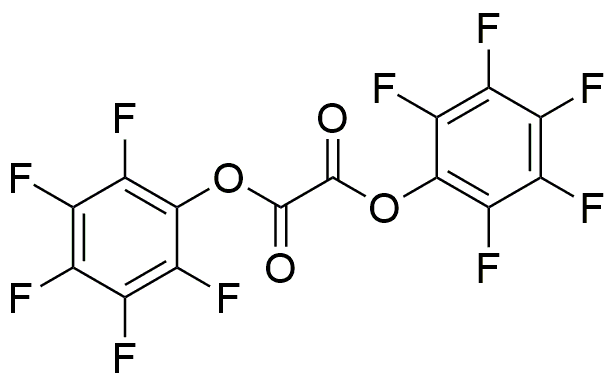Bis(pentafluorophenyl) oxalate is widely utilized in research focused on:
- Fluorinated Polymer Synthesis: This compound serves as a key intermediate in the production of high-performance fluorinated polymers, which are used in applications requiring chemical resistance and thermal stability, such as coatings and insulation materials.
- Organic Synthesis: It acts as a versatile reagent in organic synthesis, particularly in the formation of complex molecules. Researchers leverage its unique reactivity to create compounds for pharmaceuticals and agrochemicals.
- Analytical Chemistry: The compound is employed in analytical methods, including chromatography, where it helps in the separation and identification of various substances, enhancing the accuracy of analytical results.
- Fluorinated Materials Development: Industries focused on developing advanced materials utilize this chemical to create fluorinated compounds that exhibit superior properties, such as low surface energy and high thermal stability, beneficial in electronics and aerospace.
- Research in Green Chemistry: It is also explored in the context of green chemistry, where its use can lead to more sustainable processes by reducing waste and improving energy efficiency in chemical reactions.
General Information
Properties
Safety and Regulations
Applications
Bis(pentafluorophenyl) oxalate is widely utilized in research focused on:
- Fluorinated Polymer Synthesis: This compound serves as a key intermediate in the production of high-performance fluorinated polymers, which are used in applications requiring chemical resistance and thermal stability, such as coatings and insulation materials.
- Organic Synthesis: It acts as a versatile reagent in organic synthesis, particularly in the formation of complex molecules. Researchers leverage its unique reactivity to create compounds for pharmaceuticals and agrochemicals.
- Analytical Chemistry: The compound is employed in analytical methods, including chromatography, where it helps in the separation and identification of various substances, enhancing the accuracy of analytical results.
- Fluorinated Materials Development: Industries focused on developing advanced materials utilize this chemical to create fluorinated compounds that exhibit superior properties, such as low surface energy and high thermal stability, beneficial in electronics and aerospace.
- Research in Green Chemistry: It is also explored in the context of green chemistry, where its use can lead to more sustainable processes by reducing waste and improving energy efficiency in chemical reactions.
Documents
Safety Data Sheets (SDS)
The SDS provides comprehensive safety information on handling, storage, and disposal of the product.
Product Specification (PS)
The PS provides a comprehensive breakdown of the product’s properties, including chemical composition, physical state, purity, and storage requirements. It also details acceptable quality ranges and the product's intended applications.
Certificates of Analysis (COA)
Search for Certificates of Analysis (COA) by entering the products Lot Number. Lot and Batch Numbers can be found on a product’s label following the words ‘Lot’ or ‘Batch’.
Numéro de catalogue
Numéro de lot/série
Certificates Of Origin (COO)
This COO confirms the country where the product was manufactured, and also details the materials and components used in it and whether it is derived from natural, synthetic, or other specific sources. This certificate may be required for customs, trade, and regulatory compliance.
Numéro de catalogue
Numéro de lot/série
Safety Data Sheets (SDS)
The SDS provides comprehensive safety information on handling, storage, and disposal of the product.
DownloadProduct Specification (PS)
The PS provides a comprehensive breakdown of the product’s properties, including chemical composition, physical state, purity, and storage requirements. It also details acceptable quality ranges and the product's intended applications.
DownloadCertificates of Analysis (COA)
Search for Certificates of Analysis (COA) by entering the products Lot Number. Lot and Batch Numbers can be found on a product’s label following the words ‘Lot’ or ‘Batch’.
Numéro de catalogue
Numéro de lot/série
Certificates Of Origin (COO)
This COO confirms the country where the product was manufactured, and also details the materials and components used in it and whether it is derived from natural, synthetic, or other specific sources. This certificate may be required for customs, trade, and regulatory compliance.


